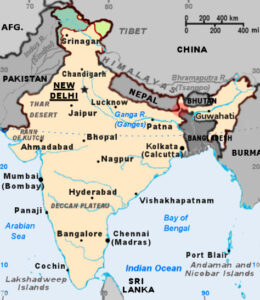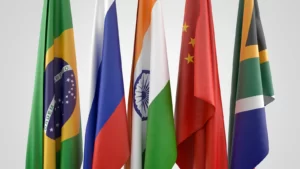- China published its new official map, including territorial claims over regions of several countries, generating great international discomfort;
- A historical period, marked by defeats and foreign invasions, influenced China’s determination to restore its sovereignty and territorial integrity, shaping its current geopolitical strategy;
- These territorial tensions have the potential to undermine mutual trust between BRICS members and provoke an eventual confrontation with the United States.
China’s territorial claims over several disputed areas have raised questions about Beijing’s imperialist ambitions and the impact of these claims on the BRICS group.
The geopolitical implications of these territorial disputes are vast and affect not only regional stability but also the global balance of power and China’s international image.

Over which territories of which countries China’s new official map makes claims
In September 2023, China made claims over several disputed territories with different countries, including:
- India: Claims over disputed lands on China’s southern border with India, especially in the Arunachal Pradesh region of northern India. It also includes the Aksai Chin region, which is controlled by China but claimed by India.
- Taiwan: The map covers the entire island of Taiwan, which is democratically governed and claims independence, but China considers Taiwan to be part of its territory.
- South China Sea: The map shows expanded claims in the South China Sea region, where several islands, reefs and maritime zones are contested by half a dozen countries, including the Philippines, Malaysia, Vietnam and Indonesia.
- Russia: The map also includes a small piece of Russia, Bolshoy Ussuriysky (or Heixiazi) Island, which lies at the confluence of two border rivers and is legally shared between Russia and China.
- Japan: This dispute centers around the group of islands known as the Senkaku Islands in Japan, Diaoyu in China and Diaoyutai in Taiwan. These uninhabited islets are located in the East China Sea, northeast of Taiwan, and are currently under Japanese administration. The presence of the United States is also notable here, as the islands are protected by a defense treaty with the US. This territorial dispute began about a decade ago, when the Japanese government decided to nationalize the islands, which led to an escalation of tensions. Since then, China has stepped up its presence in the area, sending large law enforcement ships, some equipped with autocannons, to patrol the region and claim sovereignty over the islands.
All of these territorial claims are causing tensions and protests from various governments in Asia, as well as geopolitical concerns in the region.
India expressed a strong protest against China. India’s foreign ministry has strongly rejected China’s new map, saying it lacks a solid foundation and only complicates the resolution of border issues.
Indian Foreign Minister S Jaishankar described China’s claim as “absurd” and noted that China had previously made baseless claims to territories belonging to other countries.
This territorial dispute between India and China is an ongoing source of tension between the two countries, with a border of more than 3,400 KM poorly demarcated and frequent clashes between their troops.
In the Philippines, the movement is to confront China. While Beijing says more than 90% of the South China Sea belongs to the country, other countries, including the Philippines, disagree.
The Philippines, with the support of the United States and other allied countries, has decided to no longer passively accept China’s actions and is actively defending itself. This includes allowing the US to use military bases on its territories and to hold joint military exercises.
The focal point of the dispute is an area called Ayungin Shoal, disputed over its oil and gas reserves. Although China says it has sovereignty in this area, a Special United Nations International Court ruled in favor of the Philippines in 2016.
However, with tensions rising again, the concern is that this dispute could lead to the US becoming directly involved in the conflict, which could cause even more problems in the region, as several countries are involved.
The coastal communities of the Philippines, which depend on fishing for their survival, are in the middle of this situation and face a lot of uncertainty about the future.

China’s “Century of Humiliation” and the history of territorial disputes
Current territorial disputes cannot be fully understood without taking into account the so called “Century of Humiliation“, a period that spanned much of the 19th and 20th centuries, during which China faced a series of defeats, foreign invasions and unequal treaties which resulted in the loss of territories and sovereignty.
The Century of Humiliation represents a dark chapter in Chinese history, characterized by a series of humiliating events, including the Opium Wars with the United Kingdom, the First Sino-Japanese War, and the Japanese invasion during the Second Sino-Japanese War.
During this period, China, weakened by internal and external conflicts, was forced to sign unfair treaties that resulted in the loss of territory and sovereignty to colonial powers and expansionist neighbors.
One of the landmarks of this period was the Treaty of Aigun, signed in 1858, which redistributed land on the left bank of the Amur River to Russia. This agreement is often seen as unfair by Chinese historians, arguing that Russia, a stronger power at the time, imposed disadvantageous terms on China.
Recently, China took measures to preserve the memory of these historical events, such as changing the name of a neighborhood and a village in Heihe to “Aigun”, with the aim of keeping alive the memory of the “bitter history” and territorial losses faced by the country.
The geopolitical consequences of these territorial claims are significant. They represent China’s efforts to protect its vital interests, assert its regional influence and avoid a repeat of past humiliations. However, these disputes can also create regional tensions, affect diplomatic relations and influence Chinese domestic politics.
These territorial issues, such as disputes in the South China Sea, Taiwan and other areas mentioned, are still an integral part of modern Chinese foreign policy and have crucial implications for China’s regional stability and international policy.
How China is trying to take territorial advantage of Russia’s fragility due to the war in Ukraine
China is taking advantage of Russia’s weak situation due to the war in Ukraine in several ways, including changes to its official map that rename Russian cities with Chinese names.
In February 2023, the Chinese government decided to use the ancient Chinese names of eight cities and areas that were occupied by the Russian Empire in the late 19th and early 20th centuries. This action aims to remind the Chinese people of the lands that were lost to foreign powers from the 19th century onwards.
This map change was carried out during a sensitive period, as Russia was involved in the war in Ukraine, and its border with China was weakened due to the deployment of troops and military weaponry to the Ukrainian conflict.
Russia did not officially react to this change in the map, possibly due to the need to maintain China’s support in the war against Ukraine and also against the West.
However, it is important to note that Russia reacted differently when a Polish government body advised using a different name for the Russian exclave of Kaliningrad on the Baltic Sea coast.
The Polish committee recommended that the city be called Królewiec, which was the traditional name of the area, arguing that the decision to no longer use the name Kaliningrad was related to Russia’s occupation of the region. Russia reacted indignantly to this recommendation, considering it a hostile act.
Therefore, China is using its influence and geopolitical position to take advantage of the circumstances arising from the war in Ukraine, while balancing its economic interests with the West and its relationship with Russia. This illustrates the complexity of political dynamics in the region and the challenges China faces in managing its international relations.
How territorial disputes between China and Russia and China and India could put the cohesion of the BRICS group in check
Territorial disputes between China and its neighbors, especially Russia and India, present significant challenges to the cohesion of the BRICS group – originally Brazil, Russia, India, China and South Africa –, an alliance of emerging nations that seeks cooperate on global issues and to counterbalance the “West.”
Although the nations have a history of cooperation on several fronts, including security and diplomacy issues, territorial disputes can undermine mutual trust and harm the cohesion of the BRICS group.
The fact that China has included parts of Russian territory in its new official maps demonstrates the resentment and sensitivity of these issues.
Furthermore, tensions between China and India regarding border disputes in Arunachal Pradesh and Aksai Chin are also a cause for concern for the BRICS.
India and China are two of the largest economies in the world and play important roles in the bloc. However, ongoing territorial disputes between these two members may affect the atmosphere of cooperation within the group.
India, in turn, may seek support from other BRICS members to pressure China to resolve these disputes, which could create additional tensions within the alliance.
China, as one of the group’s most influential nations, often plays a central role in the bloc’s dynamics. Therefore, territorial disputes can further deepen these differences and make it difficult for the group to maintain a common position on global issues.
In addition, Chinese President Xi Jinping’s decision not to participate in the next G20 summit in India is an additional sign of the challenges in relations between China and India, reflecting the tensions between them, which may or may not be related to the new map.
It is important to note that BRICS has faced cohesion challenges throughout its existence due to political and economic differences between its members, therefore territorial issues are an additional challenge.
The geopolitical importance of China’s territorial claims in relation to your neighbors
China’s territorial claims toward its neighbors play a central role in its geopolitical strategy, reflecting a quest for regional and global prominence.
These territorial tensions are not limited to isolated issues; they are part of a broader narrative that involves Chinese rise and assertiveness on the international stage.
After understanding the context of China’s territorial claims, it is possible to understand that this history forged a Chinese national determination to restore its sovereignty and territorial integrity.
In recent decades, its economic rise has provided the resources needed to strengthen China’s military capabilities and expand its regional influence.
So now the country seeks to use this acquired power to reassert its territorial claims, but it can be inferred that these claims go beyond territory, they demonstrate Beijing’s determination to protect its vital interests and its ambition to be treated as a regional power dominant.
Furthermore, territorial disputes can also serve as a convenient distraction for the Chinese government as it faces domestic economic challenges such as an aging population and pressures on economic growth.
In times of domestic difficulties, the Chinese leadership may attempt to direct public attention to issues of sovereignty and national security, consolidating the Chinese Communist Party’s image as the guardian of national integrity.
As a consequence, these territorial claims create regional instability, as the affected countries seek to protect their own interests and establish alliances with external powers – such as the United States – in search of support, potentially undermining the cohesion of the BRICS, where China plays a key role. leadership role.
Furthermore, territorial claims have implications for China’s international image. China’s growing insistence on territorial disputes raises concerns in the international community about Beijing’s respect for international norms and the rule of law.
This could damage China’s reputation as a responsible global actor and make it difficult to build positive diplomatic relations with other countries.
In short, China’s territorial claims towards its neighbors are an essential element of the country’s geopolitical strategy. They represent the quest to restore sovereignty after a humiliating past, the use of growing power to assert regional influence, and the need to divert attention from domestic economic challenges.
Ultimately, these territorial tensions have significant implications not only for regional stability, but also for the global balance of power and China’s international image. The topic is of great importance and must be observed, as well as its consequences on the international scene.













[…] entity that plays an important role in the global economic system. However, in recent years, China‘s emergence as the world’s largest bilateral creditor has impacted developing […]